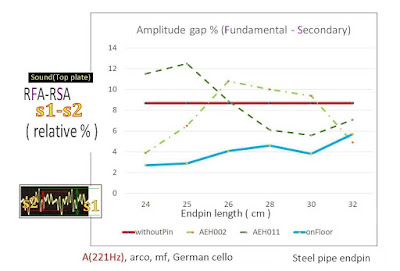[ 12/11/2018 ] Labels: 50.Endpin
When a cello is placed on the floor and the endpin is lightly struck by a stick, cello emits a pure sound, like a tuning fork with resonance box. In this case, two points of the endpin are being held or anchored. The vibration is monitored by a digital music tuner and some data were compared with former measurements and added adequate frequencies. Although some data seem to give their overtones, interesting tendency/hints came out.
(1)Firstly, in many case, endpin resonates with taking a specific frequency vibration that depends on the length of fixed two points(probably this length may correspond to 'n/2' of the wavelength. Longer the endpin is pulled out, lower changes the tone linearly. Endpin behaves like as if a (hard) string.
(2)However, syllables of the emission are not same in all materials. Endpin's diameter, density or acoustic impedance(?) or the endpin's whole length may be affecting to the result as a second factor.
エンドピンについて考察しているサイトに、「固有音響インピーダンス」という用語がしばしば使用されている。一般に「音響ピーダンス」というのは「弾性体における弾性波の伝わりにくさ」ということで、つまり物質ごとの振動の伝わりにくさ、ということのようだ。エンドピンの関連で言えば、主に材質の密度と関係がありそうだ。
しかし、安易に「エンドピンの材質ごとによって振動そのものが決まっている」かのように勘違いすることは避けなければならない。
手元のデジタル音楽チューナーをエンドピンの先端に取り付けて、チェロを床の上に置いてエンドピンを軽く叩いて、結果を表にプロットしてみよう。チューナー機器の性能も関係するが、また絶対的周波数はわからないが、最寄りの階名(A, A#, B, C,,,)とズレを表示してくれる。オクターブずれていることもあれば、時として倍音を感知していることもあるようだ。しかし、大まかな現象・共振状態を知ることができる。以前の測定結果と重ね合わせて、エンドピンの長さを変えながら各種エンドピンを調べてみた。
その結果
(1)どのエンドピンでも、長くしていくと共振する周波数が直線的に低下(低音にシフト)していくことがわかる。
棒の2点を固定して刺激を与えると、「2点間の長さを(波長の n/2 とする)振動が起こっている」ことを予想させる。長さに比例したまたはその倍音に合致した振動が起こっていると考えられる。「固定」というより、まず長さにより「可変」である。マリンバやトロンボンをイメージするほうが当を得ている。つまり、硬質な材質で作られていても、挙動としては弦・細棒が振動しているイメージでありシンプルである。
(2)全体傾向として、エンドピン長さと振動周波数はどの材質でも似た傾向にある。しかし、全材質で一致していない。また、波長と比較すると長さに従ってずれが生じてくる。ここに、径や密度の影響(音響インピーダンス?)が関係しているのかもしれない。しかし、あくまでこれは第2位以下の因子と言うべきである。
後日、正確な周波数測定を行った上で回帰分析してみるとしよう。


















































